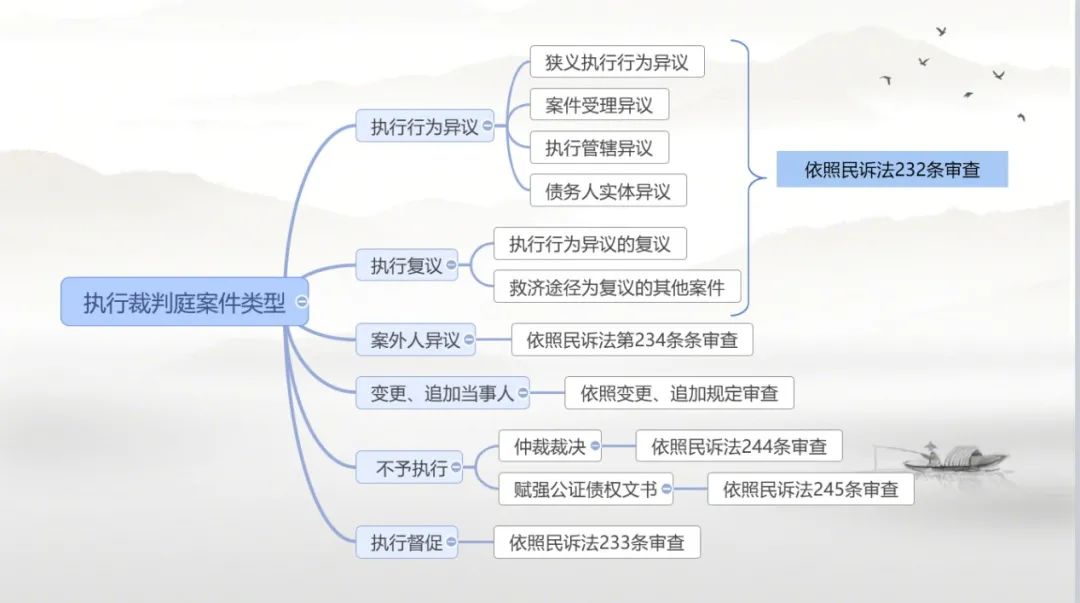
PREFACE
Civil enforcement is the most intense field where law and society, entity and procedure, theory and practice collide with each other, and it is the "battlefield" for the final battle of various complex rights and conflicts of interest. From the realization of the staged goal of "basically resolving enforcement difficulties" announced by the Supreme People's Court to the deployment of "effectively resolving enforcement difficulties" at the Fourth Plenary Session of the 18th Central Committee, the theory and practice of civil enforcement work have made great progress, and the enforcement mechanism has been well developed. The norm-building framework is becoming clearer.
I. Main Contents of the Implementation Mechanism
Civil enforcement mechanism is an organically linked whole composed of civil enforcement power separation and checks&balance mechanism, civil assistance enforcement mechanism, civil enforcement party change mechanism and civil enforcement deterrence mechanism. Among them, the check-and-balance mechanism for the separation of powers in civil enforcement is mainly aimed at civil enforcement agencies, focusing on solving the problem of standardizing enforcement according to law; the civil enforcement assistance mechanism is mainly aimed at assisting executors, focusing on solving the problem of standardizing and assisting enforcement;The civil enforcement parties change mechanism is mainly aimed at the parties involved in execution, focusing on solving the problem of the subjective scope (expansion) of execution power; the civil enforcement deterrence mechanism is mainly aimed at the whole society, focusing on solving the problem of building a social integrity system.

II. Check-and-balance mechanism for the separation of civil enforcement powers
The core of the mechanism of separation of powers and check-and-balances of civil enforcement powers lies in the formation of an effective supervision and restriction mechanism between civil enforcement powers and civil judicial powers, the executive agencies at lower and lower levels, and the internal departments of the executive agencies. Through the separation of powers, checks-and-balances and mutual supervision within the executive agencies at lower and lower levels, and the rational division of labor between the civil executive power and the civil judicial power, negative execution, improper execution and illegal execution can be detected and corrected in a timely manner, which is not only conducive to improving the efficiency and effect of civil enforcement, but also guarantees the legitimacy of the operation of civil enforcement powers, and helps to justify the realization of creditor's rights.
Since the founding of the People's Republic of China, our country's civil enforcement work has roughly gone through three stages: the separation of trial and execution, execution is attached to judgment, and the relative separation of judgment and execution. Since the late 1990s, "separation of trial and execution" has become one of the top-down enforcement reform measures implemented by the Supreme Court. The theoretical background of the separation of trial and execution is based on the division of civil enforcement power, namely, the power to execute orders, the power to execute enforcement, and the power to execute rulings (the theory also includes the power to execute judgment, the power to execute investigation, etc., but the author believes that judgment is an inherent process of thinking and decision-making, its external manifestation is the right to execute orders or the right to execute; the right to execute investigation can also be covered by the power to execute and execute).

III. Types and characteristics of cases in the execution of judicial powers
01Types of execution of adjudication cases
(1) According to the value pursuit of "separation of trial and execution" and the concept of the construction of a check-and-balance mechanism for the separation of powers in civil enforcement, and according to the division of enforcement power, the types of cases in the court's enforcement tribunal mainly include enforcement objection, enforcement reconsideration, outsider objection, Cases of changing and adding parties, non-execution and enforcement supervision.
02 Characteristics of enforcement cases
1. There are many types. There are six major categories and eleven sub-categories (the Beijing Municipal High Court will be in charge of the execution supervision cases and execution coordination cases in Beijing).
2. The trial period is shorter. Based on the pursuit of the value of enforcement efficiency, the trial time limit for enforcement judgment cases is generally shorter: 15 days for objections to enforcement actions and objections from outsiders; 30 days for ordinary reconsideration cases; 5 days for fines and detention reconsideration cases ; The trial time limit for changing or adding parties is 60 days; the trial time limit for non-enforcement cases is 60 days (the trial time limit for non-enforcement cases is expressed as two months).
3. The legal basis has a wide range of sources. More than 110 pieces of the Civil Procedure Law and its judicial interpretations, special judicial interpretations, and normative documents.

4. The system of legal supply is insufficient. Regarding enforcement, there are few provisions at the legal level, mainly including a total of 34 articles on the enforcement of the Civil Procedure Law. The rest are mostly judicial interpretations and normative documents, and there is no unified Enforcement Law.
5. The reason is statutory. Although there are many types of enforcement judgment cases, all must strictly follow the principle of statutory cause, and objections raised for non-legal cause should be rejected procedurally (for example, a case where a spouse is added as the person to be executed on the grounds of public debt).
6. "The program has a small opening and a lot of physical content." From the point of view of the path of starting the procedure of objection cases, it is mainly the procedural provisions of the Civil Procedure Law, but the specific objection cases involved should not only be based on numerous judicial interpretations and normative documents on enforcement, but also comply with various regulations of substantive laws.
7. Limited substantive examination. The remedies are relatively strict standards for the case review of the enforcement objection action. In practice, limited substantive review is carried out strictly in accordance with the relevant provisions, and the discretion based on the provisions of the substantive law is extremely prudent.

IV. the overall trend of implementation
On October 27, 2021, the "Zhong Zhengsheng" article titled "Keep an eye on the "eight difficult issues", speed up the investigation and rectification, and make sure that the second batch of educational rectification does not go through the motions. The article indicates that the improvement and enforcement power restricts and supervises the mechanism, explores and deepens the separation of enforcement adjudication power and enforcement power, and establishes an enforcement management model of "unified management, unified coordination, and unified command" supported by informatization, and actively promote the promulgation of the "Civil Enforcement Law" to solve outstanding problems in enforcement from the legal level. And in recent years, the Supreme People's Court has "strive to promote the work of civil enforcement to highlight the mandatory enforcement, promote the informatization of enforcement, and emphasize the standardization of enforcement."
01.The "Enforcement Law" is about to come out
Since the Standing Committee of the Ninth National People's Congress included the "Civil Enforcement Law" in its five-year legislative plan, until the 13th National People's Congress Standing Committee included the "Civil Enforcement Law" in its legislative plan and authorized the Supreme People's Court to lead the drafting, and then In September 2019, the Supreme Court drafted the "Draft of the Civil Enforcement Law of the People's Republic of China (Draft for Comment)", and then to the central government's statement on actively promoting the introduction of the "Civil Enforcement Law", the "Civil Enforcement Law" can be expected in the future.

02.The "Enforcement Law" is about to come out
Since the Standing Committee of the Ninth National People's Congress included the "Civil Enforcement Law" in its five-year legislative plan, until the 13th National People's Congress Standing Committee included the "Civil Enforcement Law" in its legislative plan and authorized the Supreme People's Court to lead the drafting, and then In September 2019, the Supreme Court drafted the "Draft of the Civil Enforcement Law of the People's Republic of China (Draft for Comment)", and then to the central government's statement on actively promoting the introduction of the "Civil Enforcement Law", the "Civil Enforcement Law" can be expected in the future.
03.Further improve the degree of implementation of informatization
In recent years, relying on informatization to help "basically solve enforcement difficulties", the court has formulated the "Five-Year Development Plan for Informatization Construction of People's Courts", put forward the goals and tasks of building the 3.0 version of informatization of people's courts, and established a wide-ranging and powerful system. The network system has played an active role in improving execution capabilities, standardizing execution behaviors, and improving execution quality and efficiency. Enforcement informatization is mainly reflected in internal and external aspects. Externally, the main purpose is to improve enforcement capability and enforcement efficiency, which belongs to the category of civil assistance enforcement mechanism and civil enforcement deterrence mechanism. Internally, it is mainly reflected in improving the degree of standardization of enforcement, it facilitates the flow of enforcement information and strengthens enforcement management, and serves the civil enforcement power separation and check-and-balance mechanism and the civil enforcement party change mechanism.

04.The degree of standardization of execution is further strengthened
The "Civil Enforcement Law" is about to come out, the further improvement of the implementation of informatization, the spillover effect of the results of education and rectification and the introduction of normative documents in various places, the passing of the painful period of the post system reform, the further deepening of the separation system between trial and execution, from the central to the local re-understanding of the importance of implementation work, the degree of standardization of implementation work will be further strengthened.
Summarize
The theory and practice of the rule of law of socialism with Chinese characteristics has effectively guaranteed social fairness and justice. As an important part of the socialist core values, fairness and justice are the ultimate goals pursued by society. The judiciary is the last line of defense to maintain fairness and justice, and enforcement is the last line of defense to maintain judicial fairness and justice and embody substantial fairness and justice. It would not be an exaggeration to say that enforcement bears the ultimate mission of judicial substantive fairness and justice. How to implement fairness and justice from a single judgment document to every party and stakeholder reflects the theoretical and practical aspects of legal workers in the field of enforcement and the double foundation and strength of practice. In the future, in the form of a series of articles, the author will conduct in-depth analysis and demonstration on the types and characteristics of enforcement cases by taking the field of enforcement as the entry point, and in the form of analysis cases.
Statement:
This article was originally created by lawyers of JAVY Law Firm, and only represents the author's own views, and should not be regarded as a formal legal opinion or suggestion issued by JAVY Law Firm or her lawyers. If you need to reprint or quote any content of this article, please indicate the source. Thanx!
© Beijing JAVY Law Firm Beijing ICP Registration No. 18018264-1